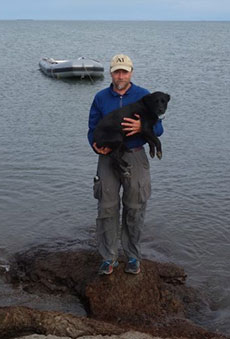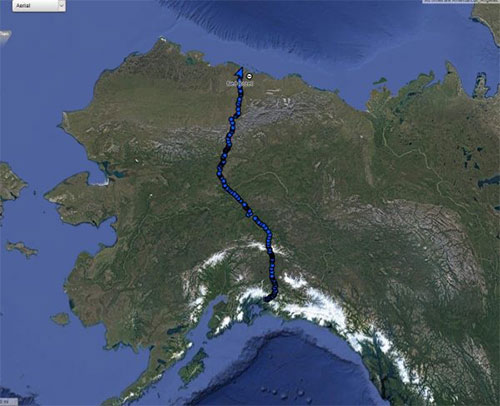
Hike across Alaska ends with after-dinner bearBy NED ROZELL
August 29, 2017
Though the orange-and-black mile markers along the pipe read 800 in Valdez and 0 near Prudhoe Bay, due to our diversions my GPS tracker recorded more than 850 miles walked from April 30 to mid-August. Cora, of course, probably logged 100 extra miles though the boreal brush that wore out one dog pack and did a pretty good job on the second. Since late April, those chestnut-backed chickadees we saw mating in the Valdez rainforest have raised at least one brood of chicks. The migrant birds, including the millions of ducks and geese on Alaska’s North Slope, will lift from northern lakes for the final time soon, to spend winter far away. Cora and I are home in Fairbanks now, appreciating chairs and dog beds, getting back to the busyness of real life and missing the daily charge of the first few steps. Before I get back to some real science writing (and thanks to my boss Sue Mitchell for accepting a summer of semi-science writing), here are some closing thoughts about the trip. Our final evening of camping was on cobbles underneath the Mile 10 sign of the pipeline. There, Cora and I were on the coastal plain of the Arctic Ocean — wet tundra and big rectangular lakes a few feet above sea level. We had just diverged from the Sagavanirktok River and nearby Dalton Highway, which is loud with the beeps and groans of graders and compactors. Heading north toward Pump Station 1, the pipeline bends a few miles away from Alaska’s farthest-north highway. The scenery changes from river gravel to green tundra grasses and plants. The dominant sounds are the laughter of white-fronted geese and the croaks of sandhill cranes. That final night, I camped in the exact spot I had 20 years ago, my tent footprint covering the same gravel. The evening was stunning and unlikely: warm, with no breeze and, somehow, no mosquitoes. There, as I was heating water for my second cup of tea, I noticed a blond smudge on the tundra. Grizzly. Just the second bear seen in 95 days. It was far enough that Cora did not notice it, but a primal thrill ran though me. The breeze was blowing from the bear toward us. It had not yet detected us but was wandering closer. To push the action, I banged a rock on the half-inch steel of a pipeline vertical support member. The bear raised its head. I walked 20 steps and back so the bear could see movement. It seemed to be studying us for a second. Then its head lowered to the ground, perhaps sniffing out a ground squirrel. I continued to prepare for the night in the tent. As I did every night when the pipeline was above ground, I threw a length of parachute cord over the four-foot tube. I attached the cord with a slipknot to the bag that held my food and Cora’s dog pack. Then I pulled the bag atop the pipeline and tied off the cord to a vertical support member.
I spent the next hour watching the bear wander. It then disappeared over bumpy tundra, heading for a lake the GPS said was three miles away. My heart rate slowed as Cora and I entered the tent. The bear had made the decision I hoped. And so it ended: Ninety-six days of summer 2017 sleeping in the home of black and grizzly bears. No unpleasant encounters. Add that to the 120 days of my trip 20 years ago and that’s more than half a year of uneventful living in bear country. Last night at dinner, a friend pointed out that we know at least seven people (including my wife Kristen) who have been attacked or have otherwise had bad interactions with bears. One terrible episode involving a friend happened this summer near Pogo Mine, not far from where I was walking. Why did Cora and I dodge bears all summer, as Jane, my dog companion for the previous trip, and I did 20 years ago? Having a dog along might be a factor, as none of those other encounters featured one. Perhaps it helped to be hiking along the human infrastructure of the pipeline, traveled by workers in trucks and people on four-wheelers. But there have been plenty of documented interactions in places not so wild. Securing our food away from us and out of reach probably helped. And — this might be the most important factor — we got lucky. We didn’t run into the ursine equivalent of the disturbed human, the one who does not act like the others. So, I’m grateful for good fortune. And to the dozens of people who helped us along the way. So many acts of kindness out there, from Chris and Audra Carlson hosting us in an Alaska Range cabin during terrible weather to a driver for Northern Alaska Tour Co. carrying my food box across the tundra in a cloud of mosquitoes. Many people executed similar selfless acts during my self-absorbed summer. My wife Kristen and daughter Anna spent most of the summer without me and the family dog but never made me feel I should be anywhere else. My sister-in-law Sarah Ast pulled off more than a month of surrogate parenting. There are many more of you, and I’ll try to thank you in my own way. But a final nod to the Geophysical Institute for paying me to write these columns and enjoy an atypical summer of life. For the second time. And thank you, for reading these words and traveling along with us.
Representations of fact and opinions in comments posted are solely those of the individual posters and do not represent the opinions of Sitnews.
|
|||||

